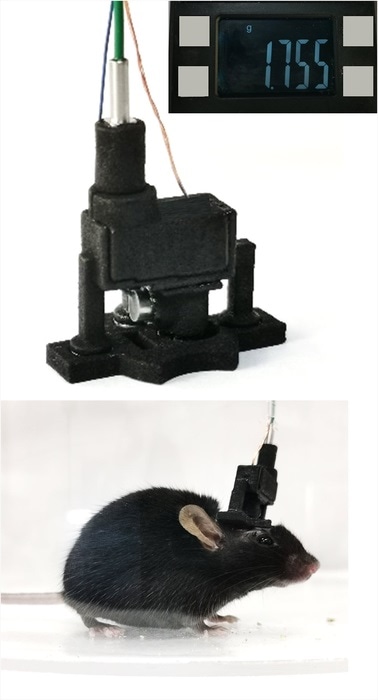Scientists recently generated the first detachable head-mounted photoacoustic microscope for imaging brain activity in freely roaming mice. The device can be detached after imaging which facilitates enduring researches that would unravel novel insights into neurodegenerative diseases and other neurological disorders.

Researchers have developed a head-mounted photoacoustic microscope that can image the brain activity in freely moving mice. The probe can be removed after imaging, making long-term studies possible. Image Credit: Lei Xi, Southern University of Science and Technology.
Epilepsy, Alzheimer’s disease, and Parkinson’s disease can all seriously interrupt neurovascular coupling—the link between neural activity and subsequent changes in cerebral blood flow. Our new probe is ideal for studying neurovascular coupling because it has the potential to capture the dynamics of both neuron and vascular networks simultaneously.”
Lei Xi, Research Team Leader, Southern University of Science and Technology
The novel microscope probe weighs 1.8 g and is dependent on optical-resolution photoacoustic microscopy (ORPAM). ORPAM captures anatomical and functional dynamics of the brain without the need for fluorescent tags or labels.
Xi and coworkers detailed the optimization of the design of the new probe to construct it light enough for use in freely roaming mice. The research was published in the Optics Letters journal of the Optica Publishing Group.
Head-mounted microscopes that use multi-photon or fluorescence imaging primarily capture the activities of single neurons. Our ORPAM probe can capture cerebral vascular network and hemodynamics of large portions of the cerebral cortex with capillary-level resolution without requiring any labels.”
Lei Xi, Research Team Leader, Southern University of Science and Technology
Miniaturizing a microscope
The current research is based on a wearable ORPAM probe that the scientists developed earlier for freely moving rats. Even though the performance was good, it had to be fixed permanently on the rat and much heavy to be carried around by mice—the most preferred animal models for brain researches.
The scientists employed optical simulation calculations to cautiously optimize the complete light path of the microscope to create a smaller probe. They also chose high-performance miniature components in addition to a micro-electro-mechanical-system (MEMS) scanner, an aspheric lens, and a customized miniaturized piezoelectric ultrasonic detector.
The resultant probe weighed less than 10% of an adult mouse’s body weight and had a resolution of 2.8 µm and images a bigger field of view of 3 × 3 mm2. To make it detachable, the scientists also introduced three pairs of magnets connecting the imaging probe with a lightweight mounting base fastened to the mouse’s skull. The probe can be detached directly after imaging and can be reinstalled later thus facilitating repeated, long-term surveillance of freely roaming animals.
Long-term imaging
The researchers evaluated the probe’s performance on a synthetic material that imitates soft tissue and later utilized it to capture vascular networks present in the cerebral cortex of a mouse for 40 minutes. They also carried out long-term surveillance experiments that lasted for seven days. The findings of these tests revealed that the probe can offer stable and high-quality ORPAM images in freely roaming mice.
In the future, we intend to develop a probe with capillary-level resolution, video-rate imaging speed, and a field of view large enough to capture the entire mouse cerebral cortex. We want to push the performance of the probe so that even more can be learned about brain activity and how it might relate to disease and health.”
Lei Xi, Research Team Leader, Southern University of Science and Technology
Source:
Journal reference:
Guo, H., et al. (2021) Detachable head-mounted photoacoustic microscope in freely moving mice. Optics Letters. doi.org/10.1364/OL.444226.